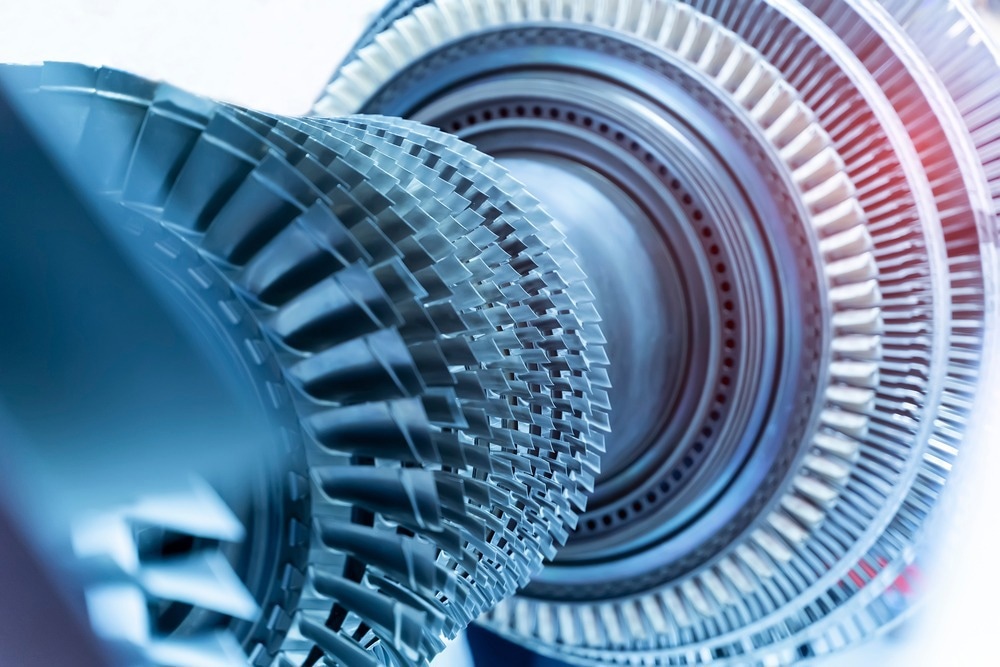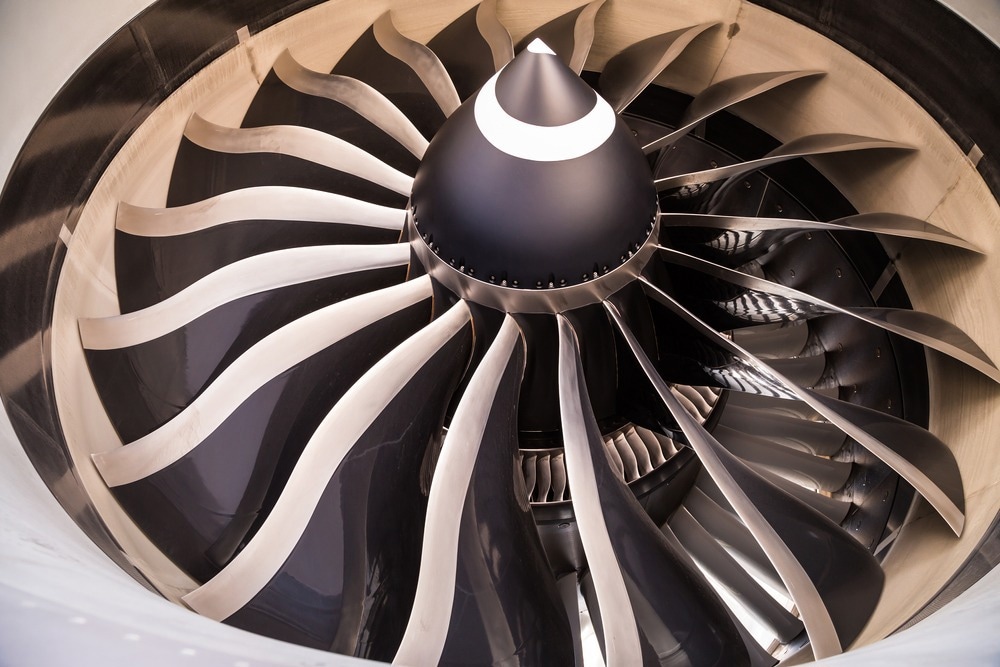The modern aerospace sector's rapid expansion has led to improvements in aircraft materials. Lowering expenses, lightweighting, and extending the operational life of the components in aircraft structures are primary drivers.
Composites are materials created by blending two or more distinct materials, typically with dissimilar properties, to produce a substance with useful attributes. This article focuses on the advantages and applications of novel composite materials utilized in the aerospace industry.

Image Credit: asharkyu/Shutterstock.com
Advantages of Utilizing Composites in the Aerospace Sector
Composites are gaining popularity in aerospace engineering for a variety of factors. They are significantly lighter than conventional materials such as metals. Weight reduction is crucial in aerospace engineering because it improves engine performance and reduces emissions. Lightweight composites are useful in reducing both the financial expenses and the ecological effects of the aerospace sector.
Composites are highly versatile due to their ability to be molded into complex configurations. Without being restricted by the limitations of conventional materials, engineers can construct parts that have been customized to suit the requirements of a specific aircraft.
Composites are also extremely resistant to weathering and fatigue, making them ideal for aircraft construction. Their ability to withstand exceptionally high temperatures is a major advantage, especially for applications in spacecraft and re-entry vehicles. For these reasons, composites are utilized for building primary load-bearing structures of aircraft and spacecraft, such as wings, fuselage, landing gear, engine nacelles, etc.
Reinforced Carbon Fiber Composites for Aerospace Applications
In the past few years, carbon fiber reinforced polymer (CFRP) composites have become an essential material for aerospace and wind energy equipment due to their compact size, excellent durability, and corrosion-resistant properties. Due to their low density, carbon fiber-reinforced carbon matrix composites, also known as carbon/carbon (C/C) composites, are an outstanding component of lightweight composites.
Over fifty percent of the airframes of the two highly popular long-range aircraft, the Airbus A350 and the Boeing 787, are comprised of CFRPs. The A380 was the first aircraft to feature a CFRP composite core wing box, saving up to 1.5 tons compared to the most advanced aluminum alloys.
In the latest article published in Composites Part B, the authors reported compact carbon fiber composites strengthened by hafnium carbide nanowires (HfCNWs). The incorporation of HfCNWs into C/C composites resulted in the development of a lightweight HfCNWs-C/C composite. The tensile strength of the two types of composites following annealing at temperatures of 1800 °C, 2100 °C, and 2450 °C were evaluated.
The mechanical strength retention rate (MSR) of HfCNWs-C/C was found to be greater than that of C/C. The mass ablation rate of C/C composites containing HfCNWs was reduced. This is because the decomposition of HfCNWs contributes to weight gain during ablation.
Therefore, it is demonstrated to be a lightweight ultra-high-temperature composite with outstanding high-temperature efficiency, demonstrating the tremendous potential for use as a thermally structural part in the aerospace sector.
Magnesium and Ceramic Composites in the Aerospace Industry
Magnesium composites are utilized in a variety of functions, including engine assemblies for aerospace vehicles, braking elements, and motion axles. On the F16 aircraft, aluminum entryways have been replaced with magnesium composites strengthened with SiC particles, thereby enhancing fatigue life.
Particularly necessary for gas turbine blades are materials that can withstand high temperatures. Extremely lightweight composite turbine blades maintain their strength at turbine exhaust temperatures of approximately 1050 °C.
In the automobile and aerospace fields, braking technology is presently a crucial area of research. In airplanes, the brake mechanism adjusts to the hydraulic fluid flowing through the disc (rotor and stator), generating friction that raises the exterior warmth of the component volume to between 3000 °C and 1500 °C with ceramic composites. The economic weight can be reduced by employing this material in the commercial airliner braking system.
Boeing is developing composite Nextel 610/alumino-silicate discharge nozzles and acoustical structures for commercial airplanes. GE Aviation has invested significantly in ceramic composite materials, and the F414 engine's diverging discharge sealing was initially made of ceramic Ox/Ox composite material.
Self-Healing Composites in the Aerospace Industry
As per the latest article published in the journal Polymers, self-healing composites are gaining popularity in the aerospace sector. Deterioration of composite materials is caused by impact loads. The impact damage begins as minuscule cavities and progresses to severe microscopic cracking and breakdown of the structure. Due to their enhanced cellular mobility, polymers and their composites have become ubiquitous as self-healing materials.
Co-electrospinning has been utilized to create a hybrid multiscale polycarbonate composite with self-healing core-shell nanofibers at the interfaces. In laminate composites, when interfacial injury, such as delamination, occurs, the core shell is designed to self-heal. Microcapsules containing restorative agents have been added to carbon fiber-reinforced plastic (CFRP) composites for use in aerospace to avoid delamination breakage.

Image Credit: M101Studio/Shutterstock.com
Self-healing composites are typically utilized as protective layers or obstacles in aerostructures such as fuselages, wings, combustion engines, cascades, and others. Silicon and boron-based crystalline components in the carbon matrix are also used as self-healing materials.
Applications of Nanocomposites in the Aerospace Industry
An article focusing on the utilization of nanocomposites in the aerospace industry has been published in Nanotechnology Reviews. A nanocomposite made up of nanosilica and ethylene propylene diene monomer (EPDM) rubber is being used as a thermal resistive substance for safeguarding the structural components of a spacecraft during launch. Research has been conducted on the replacement of conventional polymer-based composites in a solid rocket motor (SRM) with nanocomposites. To improve thermal insulation, thermoplastic PU elastomer nanocomposites (TPUNs) have been adopted to supplant conventional Kevlar-reinforced EPDM in SRMs.
The fabrication of nanocomposite-based stretchable sensors for SHM of morphing airplanes for tracking the development of fractures in aerospace morphing systems is an additional significant application.
Using a CNT-reinforced PP nanocomposite, a flapping-wing concept for a miniature air vehicle influenced by nature has been constructed. Experimental analysis revealed that the original frequency of the artificially constructed wing was quite similar to the resonance frequency of a dragonfly wing.
Magnetic polymer nanocomposites have also found their way into the aerospace sector, as per the research published in the journal Polymers. As electromagnetic interference (EMI) shielding materials, polymeric matrix composites treated with magnetized metallic nanoparticles are employed. Coatings and pigments based on polymer matrix nanocomposites supplemented with an inorganic substance have been developed.
This method has several benefits, including economical costs, comparable manufacturing simplicity, and the production of robust and lightweight materials. Structural Health Monitoring (SHM) is an essential method for determining the structural integrity of aerospace components. As viable elements for aerospace sensing gauges, inorganic/organic composite piezoelectric materials are utilized.
Overview of the Aerospace Composites Market
As per the report published in Marketsandmarkets, the global market for aerospace composites was estimated at USD 29.7 billion in 2022 and is anticipated to reach USD 51.6 billion by 2027, expanding at a CAGR of 11.7% from 2022 to 2027. The market is expanding because aerospace composites have exceptional performance characteristics and can withstand severe conditions. In addition, rising global demand for fuel-efficient aircraft is anticipated to drive market expansion shortly.
In short, composites are the backbone of the aerospace structural sector, and researchers all over the world are readily fabricating novel composites to ensure superior strength and performance.
More from AZoM: How Huntsman Are Creating Market-Leading Adhesives and Composites
References and Further Reading
Marketsandmarkets, 2023. Aerospace Composites Market by Fiber Types. [Online]
Available at: https://www.marketsandmarkets.com/Market-Reports/aerospace-composites-market-246663558.html
[Accessed 15 May 2023].
Romero-Fierro D et. al. (2022). Recent Trends in Magnetic Polymer Nanocomposites for Aerospace Applications: A Review. Polymers. 14(19). 4084. Available at: https://doi.org/10.3390/polym14194084
Bhat, A. et. al. (2022). "Review on nanocomposites based on aerospace applications" Nanotechnology Reviews, Vol. 10(1). pp. 237-253. Available at: https://doi.org/10.1515/ntrev-2021-0018
Parveez B. et. al. (2022). Scientific Advancements in Composite Materials for Aircraft Applications: A Review. Polymers. 14(22):5007. Available at: https://doi.org/10.3390/polym14225007
Fu, Y. et. al. (2023). Ultra-high temperature performance of carbon fiber composite reinforced by HfC nanowires: A promising lightweight composites for aerospace engineering. Vol. 250(1). 110453. Available at: https://doi.org/10.1016/j.compositesb.2022.11045
Disclaimer: The views expressed here are those of the author expressed in their private capacity and do not necessarily represent the views of AZoM.com Limited T/A AZoNetwork the owner and operator of this website. This disclaimer forms part of the Terms and conditions of use of this website.